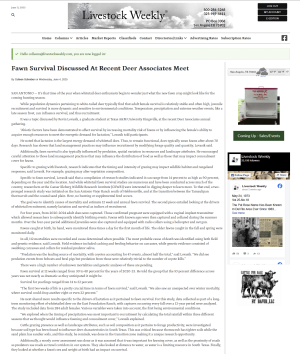
Fawn Survival Discussed At Recent Deer Associates Meeting

SAN ANTONIO — It’s that time of the year when whitetail deer enthusiasts begin to wonder just what the new fawn crop might look like for the coming hunting season.
While population dynamics pertaining to white-tailed deer typically find that adult female survival is relatively stable and often high, juvenile recruitment and survival is more dynamic and sensitive to environmental conditions. Temperature, precipitation and extreme weather events, like a late season frost, can influence survival, and thus recruitment.
It was a topic discussed by Kevin Lovasik, a graduate student at Texas A&M University Kingsville, at the recent Deer Associates annual gathering.
“Abiotic factors have been demonstrated to affect survival by increasing mortality risk of fawns or by influencing the female’s ability to acquire enough resources to meet the energetic demand for lactation,” Lovasik told participants.
He noted that lactation is the largest energy demand of whitetail does. Thus, to remain functional, does typically wean fawns after about 70 days. Research has shown that land management practices may influence recruitment by modifying forage quality and quantity, Lovasik said.
Additionally, fawn survival is also typically influenced by predation, spatial variation in resources and landscape attributes. He encouraged careful attention to those land management practices that may influence the distribution of food as well as those that may impact concealment cover for fawns.
Specific to grazing with livestock, research indicates that the timing and intensity of grazing may impact wildlife habitat and rangeland responses, said Lovasik. For example, grazing may alter vegetation composition.
Specific to fawn survival, Lovasik said that a compilation of research studies indicated it can range from 14 percent to as high as 90 percent, depending on the year and the location. And while whitetail fawn survival studies are numerous and have been conducted across much of the country, researchers at the Caesar Kleberg Wildlife Research Institute (CKWRI) were interested in digging deeper to learn more. To that end, a two pronged research study was initiated on the San Antonio Viejo Ranch south of Hebbronville, and at the transition between the Tamaulipan thornscrub and the coastal sand plain. Here, no hunting or supplemental feed occurs.
The goal was to identify causes of mortality and estimate 12 week and annual fawn survival. The second piece entailed looking at the drivers of whitetail recruitment, namely lactation and survival as indices of recruitment.
For four years, from 2020-2024 adult does were captured. Those confirmed pregnant were equipped with a vaginal implant transmitter which allowed researchers to subsequently identify birthing events. Fawns with known ages were then captured and collared during the summer months. Over the four-year period additional juveniles were also captured and equipped with radio collars using a helicopter and net gun.
Fawns caught at birth, by hand, were monitored three times a day for the first month of life. The older fawns caught in the fall and spring were monitored daily.
In all, 112 mortalities were recorded and cause determined when possible. The most probable cause of death was identified using both field and genetic evidence, said Lovasik. Field evidence included caching and feeding behavior on carcasses, while genetic evidence consisted of swabbing carcasses and collars for residual predator saliva.
“Predation was the leading source of mortality, with coyotes accounting for 47 events, almost half the total,” said Lovasik. “We did see predation events from bobcats and feral pigs but predation from those were relatively trivial to the number of coyote kills.”
There were a high number of unknown mortalities and genetic analyses of these are pending.
Fawn survival at 12 weeks ranged from 30 to 40 percent for the years of 2020-23. He told the group that the 10 percent difference across years was not nearly as dramatic as they anticipated it might be.
Survival for yearlings ranged from 14 to 32 percent.
“The first two weeks of life is a pretty crucial time in terms of fawn survival,” said Lovasik. “We also saw an unexpected over winter mortality,
where survival could drop another eight or even 22 percent.”
He next shared more results specific to the drivers of lactation as it pertained to fawn survival. For this study, data collected as part of a longterm monitoring effort of white-tailed deer on the East Foundation Ranch, with captures occurring every fall over a 13-year period were analyzed.
The study included data from 284 adult females. Various variables were taken into account, the first being environmental conditions.
“We explored when the timing of precipitation was most important to recruitment by calculating the total rainfall within three different seasons that we thought would influence fawning and concealment cover,” Lovasik explained.
Cattle grazing presence as well as landscape attributes, such as soil composition as it pertains to forage productivity, were investigated because soil type has been found to influence deer characteristics in South Texas. This was critical because thornscrub has tighter soils while the sand plain has sandier soils, and this study, he reminds, was done in the transition zone making it a unique research opportunity.
Additionally, a woody cover assessment was done as it was assumed that it was important for fawning cover, as well as the proximity of roads as predators use roads as travel corridors in our system. They also looked at distance to water, as water is a limiting resource in South Texas. Finally, they looked at whether a fawn’s sex and weight at birth had an impact on survival.
Essentially, research results found that precipitation was a significant predictor of lactation at the fall captures. The work also indicated that while cattle grazing may influence lactation, it did not impact the overall survival of fawns. Given that South Texas is typically a boom or bust ecosystem, those trying to manage for both deer and livestock may find the decision-making process a bit more challenging due to the need to balance both enterprises. When possible, he encouraged the use of rotational grazing as it’s been proven to be a viable tool for both cattle and whitetail deer management.
Roads did not have a significant impact on either probability of lactation or survival, though sex and weight of the fawn did influence survival. Lastly, not surprising, research results suggested that maintaining higher levels of brush density is likely to improve fawn survival.
Additionally, maintaining some edge effect by having a mosaic of different habitat types both in vegetation composition and configuration is important.
“Local context is important to understanding white-tail recruitment,” Lovasik concluded.